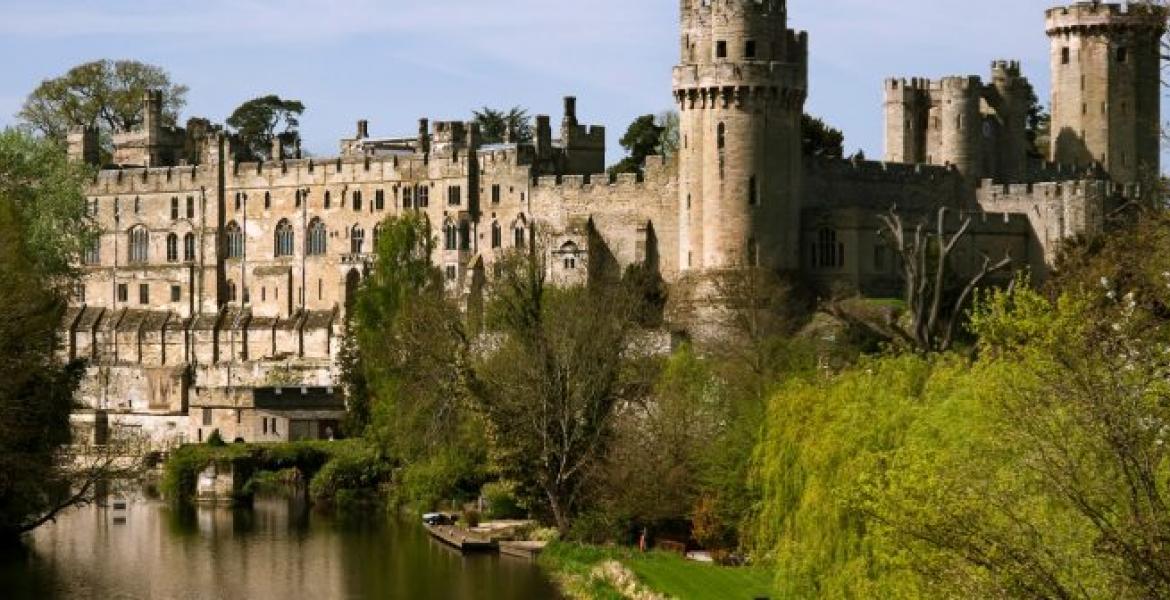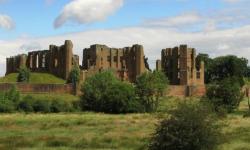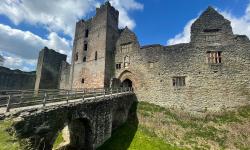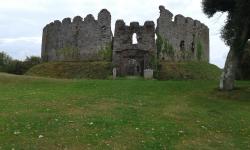Warwick Castle, Warwick
Warwick Castle has a fascinating history. The original wooden motte-and-baileyA type of castle with a raised mound (motte) and an enclosed courtyard (bailey).A type of castle with a raised mound (motte) and an enclosed courtyard (bailey). castle was built in 1068 by William the Conqueror on the site of a defensive Anglo-Saxon settlement established by Alfred the Great's warrior daughter, Æthelflæd Lady of the Mercians. Converted to stone during the twelfth century, and improved upon thereafter, it has borne witness to many rebellions, attacks and intrigues, from the Second Barons' WarA civil war, lasting from 1264 until 1267, between Henry III and some of his barons led by Simon de Montfort. Sparked by issues over crown finance and government, it it became a struggle between the power of an absolutist king and the rights of his barons.A civil war, lasting from 1264 until 1267, between Henry III and some of his barons led by Simon de Montfort. Sparked by issues over crown finance and government, it it became a struggle between the power of an absolutist king and the rights of his barons. through to the Civil War, where it remained a ParliamentarianA supporter of parliament, particularly during the Civil Wars of 1642-1651.A supporter of parliament, particularly during the Civil Wars of 1642-1651. stronghold. It also saw a bit of action in the aftermath of the Gunpowder Plot, when the conspirators stole horses from the stables to aid their escape. It was home to Richard Neville, 'the Kingmaker' during the Wars of the RosesA series of conflicts, during the second half of the fifteenth century, between two branches of the Plantagenet line: York and Lancaster. Over the course of 30 years the crown passed through several hands: Henry VI, Edward VI, Edward V, Richard III, and Henry Tudor. Most historians date the end of the Wars to Henry VII's victory at the Battle of Bosworth Field, although it can be argued that they actually finally finished during the sixteenth century.A series of conflicts, during the second half of the fifteenth century, between two branches of the PlantagenetRelating to the English royal dynasty which held the throne from the accession of Henry II in 1154 until the death of Richard III in 1485. line: York and Lancaster. Over the course of 30 years the crown passed through several hands: Henry VI, Edward VI, Edward V, Richard III, and Henry Tudor. Most historians date the end of…, hosted Elizabeth I during her tours, and was a prison for Piers Gaveston - favourite of Edward II - until his execution in 1312.
Given its history, and the fact that it is now owned by entertainment giant Merlin Entertainments, a great day out should be expected from the castle, and according to information on its website, there certainly seems a lot to do. As well as the castle grounds, towers and living quarters to explore, there are a number of special exhibitions, such as the dungeons, a Horrible Histories maze and a display showing Neville's preparations for the Battle of Barnet. At which he died, on 14th April 1471. In addition, there are talks and shows running throughout the day - including falconry and archery displays, as well as the firing of the trebuchetA machine used in medieval siege warfare for hurling large stones or other missiles.A machine used in medieval siegeA military operation in which enemy forces surround a town or building, cutting off essential supplies, with the aim of compelling those inside to surrender. warfare for hurling large stones or other missiles., one of the world's largest working siegeA military operation in which enemy forces surround a town or building, cutting off essential supplies, with the aim of compelling those inside to surrender. engines - and special events during school holidays, at Christmas and Halloween.
At which he died, on 14th April 1471. In addition, there are talks and shows running throughout the day - including falconry and archery displays, as well as the firing of the trebuchetA machine used in medieval siege warfare for hurling large stones or other missiles.A machine used in medieval siegeA military operation in which enemy forces surround a town or building, cutting off essential supplies, with the aim of compelling those inside to surrender. warfare for hurling large stones or other missiles., one of the world's largest working siegeA military operation in which enemy forces surround a town or building, cutting off essential supplies, with the aim of compelling those inside to surrender. engines - and special events during school holidays, at Christmas and Halloween.
Given a full day, it can be possible to enjoy everything, but make sure to arrive just as it opens. This way, not only is it possible to catch the ceremonial opening of the castle's portcullis, it should also be possible to avoid parking in the overflow car park, which could be up to 30 minutes' walk from the castle entrance. Also, make sure you take £6 (as at September 2016) in change to pay for the car park: the pay machines at the entrance do not like cards, nor notes (we used a £20 note to pay and received just £7 in change, all in 10p pieces). It could well be cheaper and more convenient to park in the town of Warwick. There is so much to do that a full day is needed to appreciate Warwick Castle fully, and to get value for money: at £84.50 for a family of four, £104.20 for a family of five,
Also, make sure you take £6 (as at September 2016) in change to pay for the car park: the pay machines at the entrance do not like cards, nor notes (we used a £20 note to pay and received just £7 in change, all in 10p pieces). It could well be cheaper and more convenient to park in the town of Warwick. There is so much to do that a full day is needed to appreciate Warwick Castle fully, and to get value for money: at £84.50 for a family of four, £104.20 for a family of five, Based on September 2016 prices and children over two charged entry, it is by no means a cheap day out. Advance booking can reduce the price, as can Taste Cards and English Heritage membership (both of which will get 50% off) and the vouchers which are often found on the sides of cereal packets and in magazines. There is also the option of a next day return ticket for £1, useful for those visiting on a Saturday or during a break.
Based on September 2016 prices and children over two charged entry, it is by no means a cheap day out. Advance booking can reduce the price, as can Taste Cards and English Heritage membership (both of which will get 50% off) and the vouchers which are often found on the sides of cereal packets and in magazines. There is also the option of a next day return ticket for £1, useful for those visiting on a Saturday or during a break.
The castle has done its best to ensure there are a number of attractions other than the main building, although these vary in quality and relevance. The Horrible Histories maze is new for 2016, but is not the greatest maze and is sometimes 'iffy' with the way the history is described. One of the main attractions is the dungeon, with different sections including the plague, witches, and crime and punishment. However, there is an extra charge of £9 per person, and it is not recommended for children under 10. But the star of the show must be the castle, which is immense, interesting and well-preserved. The castle provides an excellent example of medieval military architecture, and the country house within its walls shows how living arrangements and society changed over the last millennium. For those fit enough - there is a health and safety warning - it is possible to climb the walls and towers of the castle, many of which are on show for the first time in 2016, and it is also possible to tour the state rooms of the house.
Food and other visitor facilities leave something to be desired. There was little by way of choice, Only two places to eat 'proper' food were open when we visited on a busy Sunday in mid-September, leading to queues of over half an hour with the main fare being mediocre burgers and other high-fat, high-calorie options. This was served by over-worked, flustered staff who struggled to work the tills and overcharged us by £8. Sadly, places to sit down were limited, as were the toilets which, by midday, were too dirty to contemplate taking the children to. As often expected with a castle, there is not much to do for those who have mobility difficulties, with steps into almost every building, and those with pushchairs are likewise limited.
Only two places to eat 'proper' food were open when we visited on a busy Sunday in mid-September, leading to queues of over half an hour with the main fare being mediocre burgers and other high-fat, high-calorie options. This was served by over-worked, flustered staff who struggled to work the tills and overcharged us by £8. Sadly, places to sit down were limited, as were the toilets which, by midday, were too dirty to contemplate taking the children to. As often expected with a castle, there is not much to do for those who have mobility difficulties, with steps into almost every building, and those with pushchairs are likewise limited.
Warwick Castle can be an enjoyable experience, with careful planning. Try to plan the visit for a time that is not so busy, make use of offers and the £1 return wherever possible, get there early, think about parking in the town itself, and take your own food. If you do these things, it could be a great day out.
- Log in to post comments







